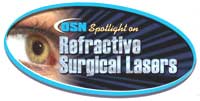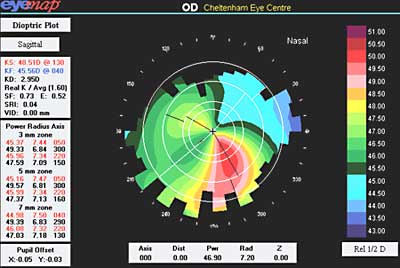PARK with vector planning for keratoconus patients maintains 10-year outcomes
All patients achieved UCVA of 20/40 or better and BCVA of 20/30 or better, according to study.

SAN DIEGO — Laser refractive surgery has long been a risky option for keratoconus patients, but a novel way of guiding ablation profiles has rendered the surgery safe and effective, according to one ophthalmologist.
OSN Refractive Surgery Board Member Noel A. Alpins, FRACO, FRCOphth, FACS, said photoastigmatic refractive keratectomy (PARK) with vector planning safely reduced myopia and astigmatism in eyes with forme fruste and mild keratoconus.
Dr. Alpins published 10-year results of the procedure in the Journal of Cataract & Refractive Surgery and presented the study at the American Society of Cataract and Refractive Surgery meeting.
Whereas most laser eye surgery is guided by refractive astigmatism, Dr. Alpins explained, vector planning uses the ocular residual astigmatism (ORA) — the vectorial difference between refractive and corneal astigmatism — to calculate ablation parameters.
 Noel A. Alpins |
Treatment by refraction or wavefront alone leaves all of the ORA on the cornea, Dr. Alpins said. Vector planning, however, puts emphasis on reducing both corneal and refractive astigmatism. The resultant astigmatic treatment is more closely aligned to the principal corneal meridian, he said.
“In this way, the corneal shape changes more favorably, with less astigmatism remaining. The treatment is less likely to create distortion of optics resulting from excess cross-cylinder effect induced by the change,” Dr. Alpins and colleague George Stamatelatos, BScOptom, wrote in the study. The reduction of excess corneal astigmatism is key for keratoconic patients, as it has an additional irregular component that may be the cause of poor outcomes commonly seen in these patients.
The study
In the study, the researchers retrospectively tracked 45 eyes of 29 patients with mild or forme fruste keratoconus who underwent the procedure. At baseline, all patients had a best corrected visual acuity of 20/40 or better, no signs of keratoconus at slit lamp, mean keratometry less than 50 D and corneal and refractive stability for at least 2 years.
“In this study group, all treatments were optimized, directing only part of the neutralization to the cornea and a theoretical part to the refraction, targeting 0.75 D or less remaining on the cornea and 0.50 D or less in the refraction,” the study authors said.
Preop mean refractive astigmatism was –1.39 D and corneal astigmatism was 1.70 D. Mean ORA was 1.34 D. Treatments overall were targeted to leave 36% of the ORA on the cornea and 64% in the refraction. Surgeons used the Visx STAR S1 or S2 excimer laser (Advanced Medical Optics) on all patients.
At 12 months postop, refractive and corneal astigmatism had improved to –0.43 D and 1.02 D, respectively. Corneal astigmatism had been targeted to be 0.75 D; the difference in the actual outcome “can be attributed to commonly prevailing healing effects and treatment factors associated with the ablation causing a less-than-perfect outcome,” they said. But better than expected refractive astigmatism was achieved.
Uncorrected visual acuity was 20/20 or better in 56% of eyes, 20/30 or better in 89% of eyes and 20/40 or better in all eyes. BCVA was 20/20 or better in 89% of eyes and 20/30 or better in all eyes. Overall, 16 eyes gained BCVA and seven eyes lost BCVA, they said.
A total of 32 eyes had 5 years of follow-up and nine eyes had 10 years of followup. At last follow-up, the group’s corneal and refractive outcomes were stable with no progression of ectasia, which may have been the result of careful patient selection, they said.
|
Image: Alpins NA, Stamatelatos G |
Case study
Dr. Alpins and Mr. Stamatelatos focused on a particularly illustrative case study.
One patient had 2.94 D of astigmatism and 86° of ORA. If treatment had been based solely on refractive parameters, they noted, all of the ORA would remain on the cornea. Therefore, the treatment plan put 50% emphasis by topography and 50% emphasis by refraction on the ORA, theoretically leaving 1.47 D of ORA on the cornea and 1.47 D in the refraction.
“To neutralize the ORA, the orientation of the target astigmatism on the cornea and in the spectacles (negative cylinder) is 176°, 90° away from the ORA axis of 86°,” the researchers said.
At 12 months postop, “the patient achieved the expected 1.50 D on the cornea but only 0.50 D of cylinder in the spectacle refraction, so not only did the corneal astigmatism reduce from 5.42 D to 1.50 D beyond the 2.94 D if treating by refractive values alone, but excess amount of astigmatism in the spectacle refraction was avoided by the advantages of less corneal astigmatism on a keratoconic cornea. This favorable outcome was common in many cases in the group and is also evident in the aggregate results,” they said.
The patient’s BCVA improved to 20/12 from 20/15, and UCVA improved from 20/120 to 20/15, they noted.
For more information:
- Noel A. Alpins, FRACO, FRCOphth, FACS, can be reached at 7 Chesterville Road, Cheltenham, Victoria 3192 Australia; 61-3-9584-6122; fax: 61-3-9585-0995; e-mail: alpins@newvisionclinics.com.au. Dr. Alpins is the creator of the ASSORT program, which was used to perform statistical analyses in the study.
Reference:
- Alpins N, Stamatelatos G. Customized photoastigmatic refractive keratectomy using combined topographic and refractive data for myopia and astigmatism in eye with forme fruste and mild keratoconus. J Cataract Refract Surg. 2007;33:591-602.
- Andy Moskowitz is an OSN Staff Writer who covers all aspects of ophthalmology.

